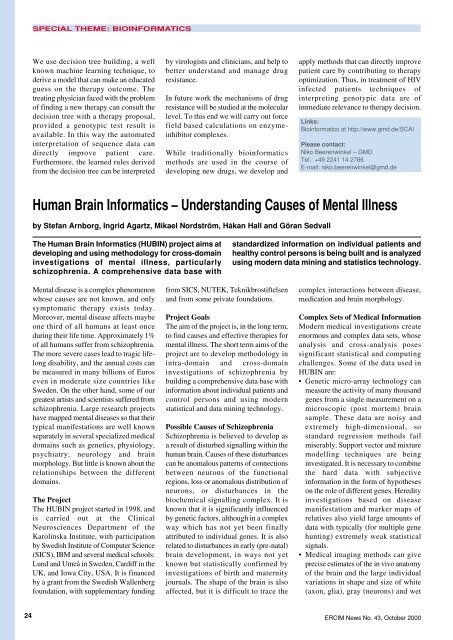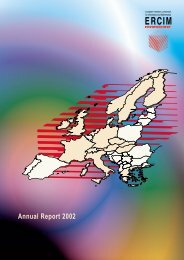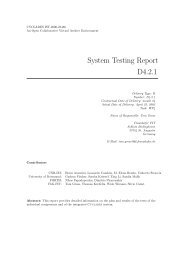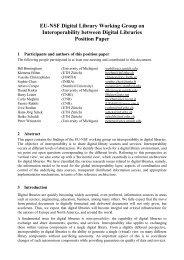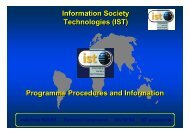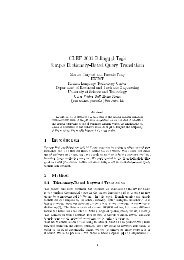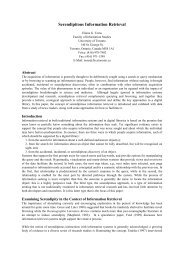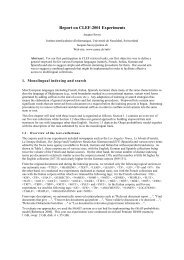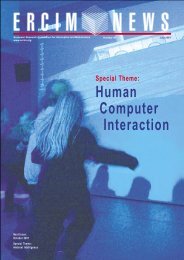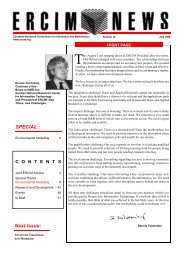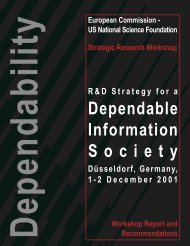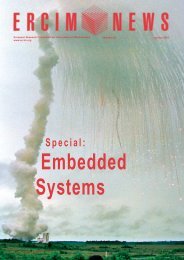Bioinformatics Biocomputing - Ercim
Bioinformatics Biocomputing - Ercim
Bioinformatics Biocomputing - Ercim
You also want an ePaper? Increase the reach of your titles
YUMPU automatically turns print PDFs into web optimized ePapers that Google loves.
SPECIAL THEME: BIOINFORMATICS<br />
We use decision tree building, a well<br />
known machine learning technique, to<br />
derive a model that can make an educated<br />
guess on the therapy outcome. The<br />
treating physician faced with the problem<br />
of finding a new therapy can consult the<br />
decision tree with a therapy proposal,<br />
provided a genotypic test result is<br />
available. In this way the automated<br />
interpretation of sequence data can<br />
directly improve patient care.<br />
Furthermore, the learned rules derived<br />
from the decision tree can be interpreted<br />
The Human Brain Informatics (HUBIN) project aims at<br />
developing and using methodology for cross-domain<br />
investigations of mental illness, particularly<br />
schizophrenia. A comprehensive data base with<br />
Mental disease is a complex phenomenon<br />
whose causes are not known, and only<br />
symptomatic therapy exists today.<br />
Moreover, mental disease affects maybe<br />
one third of all humans at least once<br />
during their life time. Approximately 1%<br />
of all humans suffer from schizophrenia.<br />
The more severe cases lead to tragic lifelong<br />
disability, and the annual costs can<br />
be measured in many billions of Euros<br />
even in moderate size countries like<br />
Sweden. On the other hand, some of our<br />
greatest artists and scientists suffered from<br />
schizophrenia. Large research projects<br />
have mapped mental diseases so that their<br />
typical manifestations are well known<br />
separately in several specialized medical<br />
domains such as genetics, physiology,<br />
psychiatry, neurology and brain<br />
morphology. But little is known about the<br />
relationships between the different<br />
domains.<br />
The Project<br />
The HUBIN project started in 1998, and<br />
is carried out at the Clinical<br />
Neurosciences Department of the<br />
Karolinska Institute, with participation<br />
by Swedish Institute of Computer Science<br />
(SICS), IBM and several medical schools:<br />
Lund and Umeå in Sweden, Cardiff in the<br />
UK, and Iowa City, USA. It is financed<br />
by a grant from the Swedish Wallenberg<br />
foundation, with supplementary funding<br />
by virologists and clinicians, and help to<br />
better understand and manage drug<br />
resistance.<br />
In future work the mechanisms of drug<br />
resistance will be studied at the molecular<br />
level. To this end we will carry out force<br />
field based calculations on enzymeinhibitor<br />
complexes.<br />
While traditionally bioinformatics<br />
methods are used in the course of<br />
developing new drugs, we develop and<br />
Human Brain Informatics – Understanding Causes of Mental Illness<br />
by Stefan Arnborg, Ingrid Agartz, Mikael Nordström, Håkan Hall and Göran Sedvall<br />
from SICS, NUTEK, Teknikbrostiftelsen<br />
and from some private foundations.<br />
Project Goals<br />
The aim of the project is, in the long term,<br />
to find causes and effective therapies for<br />
mental illness. The short term aims of the<br />
project are to develop methodology in<br />
intra-domain and cross-domain<br />
investigations of schizophrenia by<br />
building a comprehensive data base with<br />
information about individual patients and<br />
control persons and using modern<br />
statistical and data mining technology.<br />
Possible Causes of Schizophrenia<br />
Schizophrenia is believed to develop as<br />
a result of disturbed signalling within the<br />
human brain. Causes of these disturbances<br />
can be anomalous patterns of connections<br />
between neurons of the functional<br />
regions, loss or anomalous distribution of<br />
neurons, or disturbances in the<br />
biochemical signalling complex. It is<br />
known that it is significantly influenced<br />
by genetic factors, although in a complex<br />
way which has not yet been finally<br />
attributed to individual genes. It is also<br />
related to disturbances in early (pre-natal)<br />
brain development, in ways not yet<br />
known but statistically confirmed by<br />
investigations of birth and maternity<br />
journals. The shape of the brain is also<br />
affected, but it is difficult to trace the<br />
apply methods that can directly improve<br />
patient care by contributing to therapy<br />
optimization. Thus, in treatment of HIV<br />
infected patients techniques of<br />
interpreting genotypic data are of<br />
immediate relevance to therapy decision.<br />
Links:<br />
<strong>Bioinformatics</strong> at http://www.gmd.de/SCAI<br />
Please contact:<br />
Niko Beerenwinkel – GMD<br />
Tel.: +49 2241 14 2786<br />
E-mail: niko.beerenwinkel@gmd.de<br />
standardized information on individual patients and<br />
healthy control persons is being built and is analyzed<br />
using modern data mining and statistics technology.<br />
complex interactions between disease,<br />
medication and brain morphology.<br />
Complex Sets of Medical Information<br />
Modern medical investigations create<br />
enormous and complex data sets, whose<br />
analysis and cross-analysis poses<br />
significant statistical and computing<br />
challenges. Some of the data used in<br />
HUBIN are:<br />
• Genetic micro-array technology can<br />
measure the activity of many thousand<br />
genes from a single measurement on a<br />
microscopic (post mortem) brain<br />
sample. These data are noisy and<br />
extremely high-dimensional, so<br />
standard regression methods fail<br />
miserably. Support vector and mixture<br />
modelling techniques are being<br />
investigated. It is necessary to combine<br />
the hard data with subjective<br />
information in the form of hypotheses<br />
on the role of different genes. Heredity<br />
investigations based on disease<br />
manifestation and marker maps of<br />
relatives also yield large amounts of<br />
data with typically (for multiple gene<br />
hunting) extremely weak statistical<br />
signals.<br />
• Medical imaging methods can give<br />
precise estimates of the in vivo anatomy<br />
of the brain and the large individual<br />
variations in shape and size of white<br />
(axon, glia), gray (neurons) and wet<br />
24 ERCIM News No. 43, October 2000


